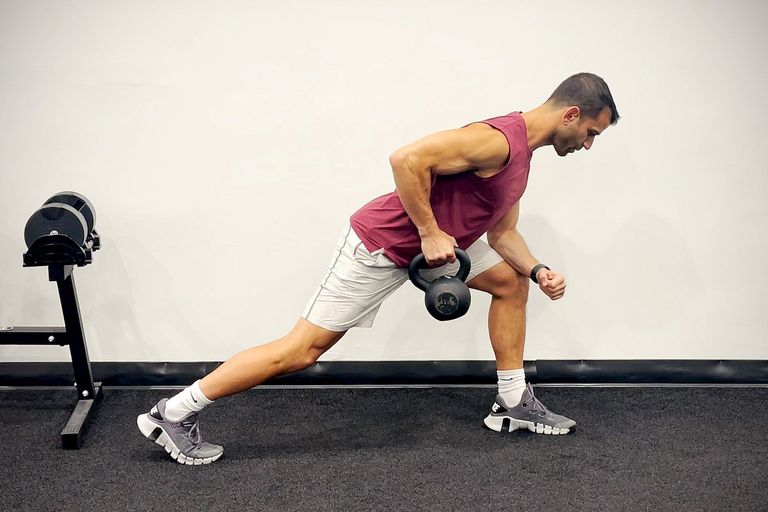The 1 Kettlebell Workout For Runners
Five functional exercises that target your arms, shoulders, chest, back, and core.
When you think of kettlebell training, your mind might go right to the swing. And that’s understandable, considering it’s such a functional exercise for runners, especially those looking to build power in their lower body. But kettlebells offer so much variety and not just for your legs. Take this upper body kettlebell workout for example.
“Kettlebells, overall, are great for runners because of their shape,” Noam Tamir, CEO and owner of TS Fitness tells Runner’s World. The shape of the weight can turn up the stability challenge in many exercises, including those in this workout, which Tamir designed. The core benefits you gain from that extra stability test—along with the upper body strength you build with these exercises—support more efficient running and solid form.
The Benefits of an Upper Body Kettlebell Workout for Runners
The exercises included in this upper body kettlebell workout will build strength in your arms, shoulders, chest, back, and core.
…kettlebells offer so much variety and not just for your legs.
Anti-rotation moves like the single-arm supported row and the floor press with glute bridge can help runners build a stronger midsection, which translates to better running form, a more efficient stride, and good posture. Meanwhile, practicing moves like the bicep curl, skull crusher, and half-kneeling overhead press will help you build strong arm muscles for a better drive.
A well-balanced upper body workout that works your muscles from many angles and targets the front and back of the body, like this one, can also help runners not only improve strength but also help you maintain good running mechanics, which makes for better performance overall.
How to use this list: Perform the exercises in the order listed below, for the number of repetitions described. Rest for 30 seconds in between each exercise. Complete 3 sets, resting for 30 to 90 seconds between each set.
Each move is demonstrated by Tamir in the video above so you can mimic proper form. You will need a kettlebell and an exercise mat for this workout.
1. Bicep Curl

Why it works: Using a kettlebell in place of a barbell or a set of dumbbells is a great way to spice up this traditional exercise. Tamir says building strong biceps will also help runners improve their arm swing for stronger runs.
How to do it: Stand with feet shoulder-width apart. Hold a kettlebell around the horn in both hands with palms facing each other, bell down in front of the body. Bend both elbows to lift the kettlebell toward the chest, keeping the elbows close to the torso. In a slow controlled motion, lower the kettlebell back down, extending elbows. Repeat. Do 10 to 12 reps.
2. Single-Arm Floor Press With Glute Bridge Hold

Why it works: This move requires runners to engage their entire body while resisting rotation, Tamir says. This helps build a stronger upper half equipped to handle the forward movements in running while eliminating side-to-side swaying that can rob you of speed.
How to do it: Lie faceup with a kettlebell in the left hand, knees bent, and feet planted on the floor. Drive through feet, engage the glutes and lift hips up toward the ceiling. With palms facing each other, send arms straight up. This is your starting position. Bend left elbow about 45 degrees away from the torso, lowering the kettlebell toward the chest and elbow toward the floor. Pause, then press back up. Repeat. Do 8 to 10 reps. Then repeat on the right side.
3. Single-Arm Supported Row

Why it works: Focus on resisting too much flexion (or rounding) in your back muscles while practicing this exercise. This will help strengthen the muscles in your back to improve your running form and forward propulsion, Tamir says, as well as help you maintain a tall posture.
How to do it: Start in a lunge position with the left foot back and kettlebell in the left hand. Hinge at hips, keeping left leg straight, and place right forearm across right thigh for support. Make sure shoulders, chest, and hips are parallel to the floor. This is your starting position. Starting with the arm straight, pull the left elbow toward the left hip, lifting the kettlebell up toward the ribcage. Hold, then slowly lower back down, straightening the arm and returning to starting position. Repeat. Do 8 to 10 reps. Then repeat on the right side.
4. Half-Kneeling Overhead Press

Why it works: Use this move to strengthen your back and core muscles. “A strong upper body helps to optimize form and absorb the impact of running,” Tamir says.
How to do it: Start kneeling with left foot forward, both knees bent 90 degrees. Hold kettlebell racked at the left shoulder, left elbow bent, left palm facing ear, and right arm down by side. Press left arm straight up with biceps by ears, then bring left arm back down to shoulder. Repeat. Do 8 to 10 reps. Then repeat on the right side.
5. Skull Crusher

Why it works: This move will counterbalance the bicep curl to help you develop stronger arms for a more efficient arm swing.
How to do it: Lie faceup with knees bent and feet flat on the floor. Hold the kettlebell with both hands around the horn and extend your arms above the chest. Slowly bend elbows to lower the kettlebell down toward the top of the head, keeping elbows over the shoulders. Press the bell back up, extending elbows. Repeat. Do 10 to 12 reps.

